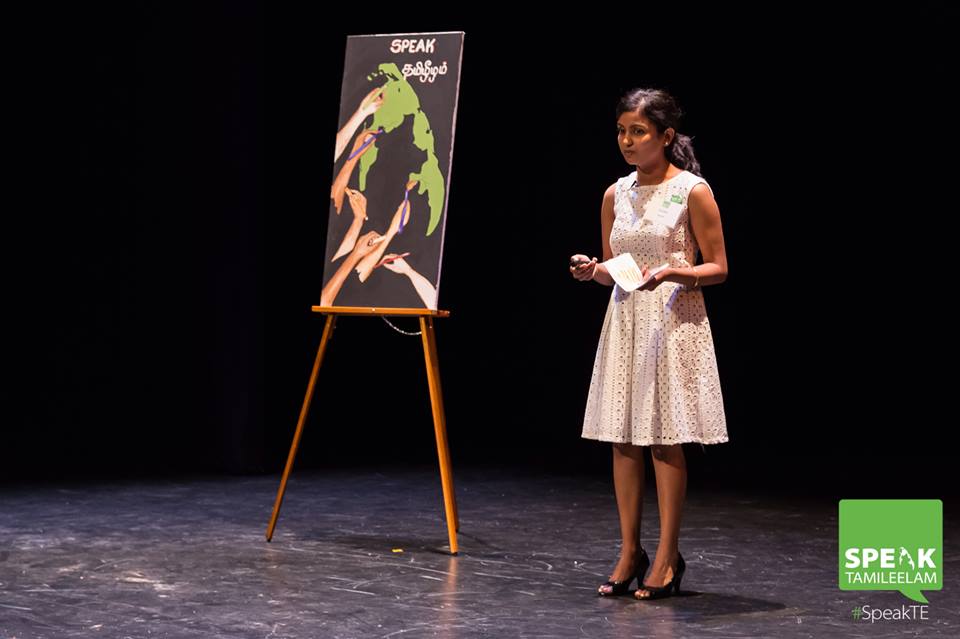Archive for the ‘Speak Out’ Category
Thoondal 6: The Beauty of ‘Art’By Editor - September 21st, 2013 |
 |
|
Doodling away into the wee hours of the night, it took me a good while to realize that the topic for this week’s Thoondal was right in front of me. Art! Now, I speak of visual arts in particular, but of course the term ‘Art’ is inclusive of so many different types of creative expression, all of which need no words to communicate. This brings me to the purpose of this piece. Music, dance and visual arts, what is it about these beautiful expressions that is able to capture our hearts and carry along the artist’s intention or message to his or her audience without using language? It is amazing how art has travelled across countries, breaking ethnic and language barriers all over the world. Even news of violence against people does not always reach a third person in its entirety. We relate to such news, but not to the extent that we must in order to feel the complete pain of the victim. How is it then that we are able to look a painting and feel the mood that the painter wanted us to feel? The colours, the strokes, the light and the shadows? Music reaches our hearts with its varied notes or sounds: the highs, the lows, the loud, the quiet, and perhaps most importantly, silence. The dancer mesmerizes us with his/her grace, quick feet, gestures, loud thumps and flashes of emotions. The pictures that are etched in the viewers’ minds as such are almost always in resemblance of the artists’ own imaginations, and it is this that is truly the beauty of ‘Art’. The ability to draw in a vast audience with no need for explanation makes ‘Art’ one of the best and strongest tool for activism, change and developing a better future. As such, the beauty of ‘Art’ is also its greatest power, and we must embrace it. Use your creativity to its highest potential and realize its utmost value. About the Author: Shayanika Suresh is a Law Graduate currently working on establishing her legal career. She is also a passionate writer and has self-published a collection of short stories, “Lips no longer sealed”. Shayanika’s passion to raise awareness of various social issues that affect individuals and society as a whole is evident in her work, leaving a message for the reader to take home. |
Thangachi’s Corner: In RemembranceBy Admin - September 10th, 2013 |
 |
|
CTYA’s Blog has started a new Feature every other Wednesday called “Thangachi’s Corner”. “Thangachi’s Corner” is a comfortable space to discuss relatable topics and issues relevant to the Canadian Tamil youth of today. For more information about this feature or to suggest a topic, feel free to e-mail us at blogs@ctya.org! Written By: Keerthana Raveendran I was in fifth grade French class when the first plane hit. At the time, precisely twelve years ago, I was entirely oblivious to what was happening at our southern neighbour. I remember sitting in groups of five, chatting away after the morning announcements as our teacher gathered her things, fascinatedly looking at the limited edition Harry Potter collectibles she’d strewn across our desks at a time when the series was gaining corporate popularity. The details of the lesson escape me to this day, but I remember vividly when the principal’s voice echoed through the PA system minutes later, interrupting us. Her voice was grave. She had an important announcement, was going to give us a minute to quieten down and prepare ourselves before speaking again. I remember as we waited with bated breath during that one minute, and then, when the broadcast hit, the stunned silence within my classroom. I remember feeling remorse at the statistics she’d guesstimated, but still, at the tender age of nine, I could not quite comprehend the extent of the damage that had been done. It wasn’t until years later than I came across the footage that had been played all over the country while I’d been in school. I was researching the incident for a school project and found myself encountering the many perspectives of the story that had unfolded that day. Older now, I came to understand the magnitude of the tragedy. The number of people who had been trapped in the upper floors of the towers, unable to escape; who felt terror upon feeling the ground beneath them shudder upon impact; for whom realization must have slowly seeped in that it was impossible to descend and escape the building with flames and plane wreckage as their obstacle below—many of them had made the heart wrenching decision to throw themselves over the edge of the building rather than to await a suffering demise at the hands of the destruction. Those innocents who sat in the planes—they expected no more than a pleasant flight, believing that their only obstacles would be the popping in their ears with altitude and perhaps a mild case of airsickness. They must have been aware of their situation well in advance, powerless to change their circumstances, left only to haphazardly swipe their credit cards through the slot of the airplane phones across from their seats, call their loved ones, and say goodbye. Those many firefighters, who risked their lives to climb the attacked buildings in an attempt to salvage lives, only to find themselves engulfed in flames. The horror of those outside the buildings, who witnessed not only one, but two planes hit. And the people at home, the husbands, wives and children who picked up the telephone, called and called and called, hoping to reach their families. I remember being nine years old and witnessing our school flag at half-mast in a gesture of respect and mourning to commemorate those who had suffered during the events of 9/11. It is now twelve years later. Our flags no longer rest at half-mast in remembrance. Families who had once lost loved ones have begun to heal. The towers that once collapsed are now being rebuilt. Tragedy is as constant in our lives as change, but with all tragedies—9/11, the World Wars; and even those in our own Tamil heritage, Black July, the Sencholai massacre—time serves to heal. Before September the eleventh became the day the United States was attacked, it signified birthdays, proposals and anniversaries around the world. For some, it was the day a coveted job was earned. For others, it was the day of reunion with loved ones after a long journey. Misfortune can reach our doorstep any day, but we are capable of changing how we view it. And so, while I might still think back from time to time on those who suffered that morning I played with Harry Potter cards in French class, I’m still quite certain that September the eleventh will hold many miracles around the world for years to come. About the Author: Keerthana Raveendran, known by her flock as Thangachi, is an aspiring author with an eye for the eccentricities of the Tamil Canadian culture. As an unemployed student with a mountain load of student debt, she is currently broke, so you will probably be able to relate to her. As a writer, she has a special kind of wit that is present on the page and absent during the awkward conversations you tend have with her in person. Thangachi is currently a Masters student studying English at York University. |
Thoondal: Do we really care about what others think?By Admin - September 5th, 2013 |
 |
|
Written By: Shayanika Suresh I often catch myself saying “I don’t care what people think, I’m going to do what I feel like doing!” But lately, I’ve been thinking. When we say that, do we actually mean that? In a world dominated by divisions, of race, class, sex and gender, do we not care what people think when we measure ourselves by these standards that have been prescribed for us by the society that we live in? When we dress in brand-named clothing and carry ourselves with grace and flair, are we not thinking about what people will think of us? When we practice etiquette at the dining table, are we not trying to maintain a certain image? Consciously and unconsciously, we are constantly trying to fit into a particular mold. We are always trying to impress others, and we yearn for compliments on a daily basis. Be it a friend, partner or spouse, we seek to be flattered, to be praised. Then, how can we say that we don’t care what others think? If we are to agree that we do care what others think, another question swiftly arises. Are our words and actions then moulded by what others think? Do we always make decisions in order to please people? In my opinion, that cannot be the case. Yes, we do reflect on what others might say or think with regards to our words, actions and decisions, but we do not make our choice solely based on this reflection. There are many occasions, I find, when we act in contrary to what other people think, solely because we feel like doing something else. But is individual choice guaranteed to win every time? Or are we in denial of how much of an impact a third person’s perception of us can have on us, as individuals? CTYA’s Blog has started a new feature every Thursday called ‘Thoondal’, meaning inspiration, stimulation, or inducement. Through these weekly features, the author hopes to inspire you, stimulate your senses and induce you to think deeply about the topics she addresses and finally, to use those thoughts to inspire many more wonderful youth like you. About the Author: Shayanika Suresh is a Law Graduate currently working on establishing her legal career. She is also a passionate writer and has self-published a collection of short stories, “Lips no longer sealed”. Shayanika’s passion to raise awareness of various social issues that affect individuals and society as a whole is evident in her work, leaving a message for the reader to take home. |
Thoondal: Let your fears go, and fight with faith!By Admin - August 29th, 2013 |
 |
|
Written By: Shayanika Suresh Take writing for example. I know I love to write, and I always have. But, am I good at it? That question has crossed my mind too many useless times, and I am certainly not proud of it. This book, however, has made me realize that I am not the only victim of such thinking. Perhaps that was the purpose of the gift, and I am ever so grateful for it. For many years, I shied away from socializing, hiding my huge plastic glasses behind a book, no matter where I went. I barely spoke a word in class, and muttered in response when I was spoken to. With my closest of friends, I would speak with enthusiasm, laugh out loudly but all that quickly disappeared in the midst of a stranger. For those who know me now, I have clearly come a long way from the shy me, but my fears shift onto other subjects each and every day, and as such, every day is a fight for my faith. That which has captured my passion, I am able to conquer with ease, and that which I fear, I am imprisoned by. It is this fear, I have realized, that is my biggest enemy, and I am sure there are many more like me. To those like me, I write this piece. The first step to victory is overcoming your fears. The first step to overcoming your fears is to admit them. Open up to yourself. You need not tell the world, but don’t fail to tell yourself. Once you admit the fear is there, you will be able to take the next step to fight it. Every day is a gift that has been granted to us. Yes, we often take it for granted, and we do not realize its value. But it really is a gift to live, and we are blessed to be able to live our dreams. So why should we let our fears stop us from living those dreams? Fear of losing, fear of dying. Who cares? Let the future be what it chooses to be. Live the present with all your heart, and work towards achieving your dreams. However far you go, that itself is an accomplishment worth celebrating. Every day, I am pushed and driven by beautiful people in my life, to reach further and higher. To those people I am blessed to have in my life, this is my little thank you. About the Author: Shayanika Suresh is a Law Graduate currently working on establishing her legal career. She is also a passionate writer and has self-published a collection of short stories, “Lips no longer sealed”. Shayanika’s passion to raise awareness of various social issues that affect individuals and society as a whole is evident in her work, leaving a message for the reader to take home. |
Thangachi’s Corner: The Art of Tamil CuisineBy Admin - August 28th, 2013 |
 |
|
CTYA’s Blog has started a new Feature every other Wednesday called “Thangachi’s Corner”. “Thangachi’s Corner” is a comfortable space to discuss relatable topics and issues relevant to the Canadian Tamil youth of today. For more information about this feature or to suggest a topic, feel free to e-mail us at blogs@ctya.org! Written By: Keerthana Raveendran The task of learning Tamil cuisine was my Everest once upon a time. I spent a lot of time helping my mother cook as a child, was preparing breakfast for my family every morning by the time I was in grade seven, and could follow a recipe to the letter to make anything I wanted, but when it came to Tamil food, I was stumped. You see, I always need a plan. I need to know exactly what has to be done before I do it. I need to be able to coordinate multiple tasks to ensure maximum efficiency. In fact, while cooking, I even make a point of looking through the Nutrition Facts labels to simultaneously optimize health benefits. This particular nature made it all the more difficult for me when I realized that Tamil cuisine was very much about the senses. While I, who have taken a myriad of chemistry courses in the past, am rather procedural in the precise manner that I use lists and follow recipes, Tamil cuisine focuses instead on the experience. There is no set measurement regarding the amount of salt that is put into this curry or that. You don’t measure the amount of onions you slice, count out a specific number of curry leaves to wash, or quantify individual mustard or fennel seeds in teaspoons before tossing them into the pot. Instead, it is your intuition that is put to work as you ballpark these values in a trial and error fashion. This makes for a very subjective process that puts quite a bit of responsibility onto the chef, as what is too salty for one may be tasteless for another. I suddenly understood why a lot of the Tamil adults with whom I came into contact often complained about high blood pressure. Read more |
Senthamil Things: A Man’s Best FriendBy Admin - August 20th, 2013 |
 |
|
By: Senthamil Stefi In 1870 in a courtroom in Missouri, United States, George Graham Vest represented a farmer who was suing his neighbour for shooting his dog. Representing this client, Vest closed the trial with his statement, “The one absolutely unselfish friend that a man can have in this selfish world, the one that never deserts him and the one that never proves ungrateful or treacherous is his dog.” This phrase was than shortened to a dog being “a man’s best friend,” and that is how this phrase emerged into society. Indisputably, dogs have been labeled as “a man’s best friend” time and time again due to their nature of loyalty and amazing sense of companionship. Though not “all” dogs are friendly by nature, their sense of loyalty remains consistent which seems to heavily lack in our human world. Now, how did they become “a man’s best friend”? Before the 18th century, dogs were generally not kept as household pets but rather were used to aid in hunting, guarding, or work. The ones that were kept at home were very small and were labeled as “lap dogs”. They were not regarded highly by society. Beginning in the mid-1700s, the notion of dogs as nurtured and favourable household pets began to appear. Dog hospitals, dog food and many other dog essentials emerged during the 19th century. Now during recent times, it is clearly evident in our society of the western world that dogs are valued just as much as children, as terms such as “dognapper” and “dognapping” have been adapted. I guess it can be said that a dog was “always” a man’s best friend…it just took humans a long time to realize that and appreciate it. In summary, human beings are selfish in nature… whereas dogs are some of the most self-less beings in the world that will be there for you no matter what…thus, making out to be the best depiction of what a TRUE best friend is. |
Thulirkal: Painting with Purpose, Keera Ratnam!By Admin - August 19th, 2013 |
 |
|
CTYA’s Blog has started a new Feature on Fridays, Thulirkal. Thulirkal meaning bud reflects the young Tamil youth we will befeaturing. These youth are the buds of our community, and are growing into to strong, achieving young men and women! Each week we will feature a Tamil youth of the week. For more information or to suggest a youth to feature, please feel free to email us at blogs@ctya.org! This week, we’ve brought you, Keera Ratnam! Thank you for joining us today Keera. So, let’s get warmed up. Ok, now don’t think, just say what first comes to mind. 1, 2, 3… Art or Music? Art Three things you would take on Desert Island? Pencil, paper and a compass. Favourite Painting Medium? Water colour If you were invisible where would you go? Tamileelam’s isolated and banned Vanni camps Short Hair or Long Hair? Love long hair, but my hair is too heavy and too curly so I have to make it short. Early Riser or Night Hawk? It all depends when I paint. Early riser if I have to paint, and night hawk if I am kept up painting. Some days I sleep at 4 am painting. So everything depends on my painting. My work is my life. |
Thoondal: Dear Smartphone Users…By Admin - August 15th, 2013 |
 |
|
CTYA’s Blog has started a new feature every Thursday called ‘Thoondal’, meaning inspiration, stimulation, or inducement. Through these weekly features, the author hopes to inspire you, stimulate your senses and induce you to think deeply about the topics she addresses and finally, to use those thoughts to inspire many more wonderful youth like you. Written By: Shayanika Suresh Thoondal: Dear Smartphone Users… Have you been neglecting your desktop computer or laptop lately? Or have you abandoned it completely? Are you now browsing the internet, checking your social networks, and playing games, all on your smartphone? Yes? Then, I believe we are on the same page. The way technology has evaded our universe and the rate at which it has done so is simply incredible. The existence of our modern society is now entirely or at least for the most part, dependent on technology. In the morning, we wake up to the alarm set on our phones. Some of us use electric toothbrushes, trimmers, hair dryers, and straighteners. We boil water in electric kettles and warm our food in microwaves. We vacuum our rooms, we mow our lawns, and we plug in the snowblowers to clean our driveways in the winter. That’s sociological advancement, no doubt, but as a result, are we failing to maintain interpersonal relationships with others ‘in person’? Or at least, spending less time doing that than messaging friends on facebook, and emailing our professors? I believe this personal connection is essential to our society, as it allows us to judge character, to distinguish honesty from treachery, and to express our emotions to an extent that no emoticon could ever completely fulfil. The question then is, how do we balance these two exciting worlds? What do we do to ensure that we remain personally connected to the people in our networks despite our super cool gadgets? About the Author: Shayanika Suresh is a Law Graduate currently working on establishing her legal career. She is also a passionate writer and has self-published a collection of short stories, “Lips no longer sealed”. Shayanika’s passion to raise awareness of various social issues that affect individuals and society as a whole is evident in her work, leaving a message for the reader to take home. |
Thangachi’s Corner: The Proverbial Culture PieBy Admin - August 15th, 2013 |
 |
|
August 14, 2013 CTYA’s Blog has started a new Feature every other Wednesday called “Thangachi’s Corner”. “Thangachi’s Corner” is a comfortable space to discuss relatable topics and issues relevant to the Canadian Tamil youth of today. For more information about this feature or to suggest a topic, feel free to e-mail us at blogs@ctya.org! Written By: Keerthana Raveendran I have a confession. I don’t watch Tamil movies. If you’re like a lot of the Tamil people I’ve encountered, I can probably guess what you’re thinking, right down to the tone of disbelief. “What?” That’s usually the response I get when the latest Tamil cinema hit is being discussed and I make this particular admission. It is then often followed by one of two things: a “Why?” that possibly compels folks to convince me to watch said movies; or the immediate, and occasionally vocalized assumption that I just must be “whitewashed”. Now, let’s take a look at that word – whitewashed. As it is more often than not used in colloquial language, it’s only fair to define it as such. Urban Dictionary describes whitewash as, “a process […] when a person who is considered a minority adopts a lifestyle (including speech, mannerisms, clothing, etc.) that is attributed secludedly to those of European descent, white people”. Okay, fair enough. If “whitewash” is defined by lifestyle, it is understandable enough how steering away from Tamil cinema presumably diminishes one’s Tamil identity in our society. Because these days, isn’t culture defined by the media? That is where we make the miscalculation. It is important to recognize that the intricate concept of culture is made up of not only media, but a plethora of other features as well, such as language, society, cuisine, clothing and tradition. Each of these aspects serves as a slice in the proverbial pie (or similar circular baked good) of culture. It hardly seems fair to define our entire Tamil culture by the one slice. On my part, as Tamil movies were deemed inappropriate by my parents growing up, I had never been accustomed to watching them regularly. And having never had a reason to be “hooked”, I became attached to a different kind of Tamil movie – Tamil-dubbed Ramayanan and even better, Mahabharatham. The stories captivated me. There were enough episodes to keep me interested, and I was exposed every day to not only Tamil speech, but to Thiruvalluvar’s Tamil—clean, refined and antiquated enough to be Shakespeare’s Tamil equivalent. I wonder then, exactly how whitewashed I am. I may not know what the latest Tamil movie is, and I may prefer to re-watch epic Breaking Bad episodes rather than endure Tamil dramas on TVI, but that doesn’t brand me as any less Tamil than the regular movie-goer. It is always a tricky game to define a concept as complex as culture, but I know enough to avoid limiting the definition to one trifling aspect. After all, we Tamils are so much more. About the Author: Keerthana Raveendran, known by her flock as Thangachi, is an aspiring author with an eye for the eccentricities of the Tamil Canadian culture. As an unemployed student with a mountain load of student debt, she is currently broke, so you will probably be able to relate to her. As a writer, she has a special kind of wit that is present on the page and absent during the awkward conversations you tend have with her in person. Thangachi is currently a Masters student studying English at York University. |
Remembering Sencholai Orphanage MassacreBy Admin - August 14th, 2013 |
 |
|
Written By: Mathusan Mahalingam on behalf of Thazhumbakam Education On August 14, 2006, 61 innocent young Tamil girls lost their lives. It was not a random act, but rather, a premeditated act, now known as the Sencholai Massacare. Sencholai Orphanage was an orphanage that provided much needed refuge, counsel, belonging and education to girls who were left orphaned in the 2004 Tsunami. Sencholai provided a way out of poverty for these girls through education. On August 14, 2006, children from Sencholai, and neighboring schools were brought in for a two-day seminar on First Aid. In regions affected by war, the importance of understanding first aid and being able to treat someone using this knowledge becomes much more crucial – the knowledge of first aid determines life or death. Having trained people able to administer first aid can help quickly treat those injured or wounded in attacks of war. Around 7am in the morning of August 14, 2006, Kfir jet bombers of the Sri Lankan Air Force moved in on Sencholai Orphanage, and in a premeditated attack, engaged in heavy aerial bombing targeted at the Sencholai Orphange. 61 children, all young girls with promising futures ahead of them were killed in the heavy aerial bombing. Over 150 others, all girls, were also seriously injured. In genocide, education is one of the targets. Undermining a population economically and preventing its growth can be done simply through hindering educational opportunities for the targeted group. This attack was aimed at undermining the progress of Tamil children. According to the Fourth Geneva Convention of War, which outlines the Protection of Civilian Persons in Time of War, civilians are not to be targeted. Sencholai Orphanage was located in a designated “humanitarian zone,” and therefore “must be treated humanely at all times, and should be protected against acts or threats of violence.” However, despite Sri-Lanka being a signatory of this Convention, they intentionally targeted and attacked these young schoolgirls. The Sencholai Massacre was a grave injustice, it must be looked at as part of a larger plan for genocide. . Targeting these girls, who would have proven to be invaluable at providing first aid during other genocidal attacks (May 2009) is not something to be taken lightly. The Sencholai Massacre was part of a larger plan for genocide. |

